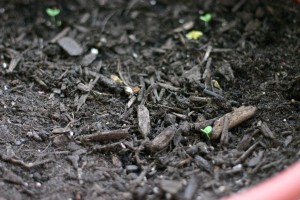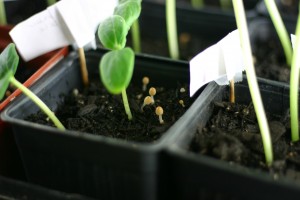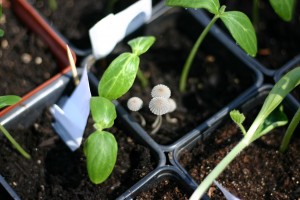I’ve recently been very disgusted with the state of potting soil that I’ve bought at garden centers and hardware stores recently. To me this “potting soil” it looks like black mulch with some pearlite and something vaguely organic mixed in. Great big twigs and splinters of wood run throughout the stuff, making it difficult to work with, scoop, measure, and sprout seeds.
In the photo above you can see how much un-decomposed wood there is in this particular batch of potting soil. The seedlings really have a tough time pushing through this stuff to break the surface and get to light. It’s almost like someone chipped some wood and mixed it with a small amount of sand and compost and called it “soil”. As an augmentation for the soil already in the ground in your garden this can work, but for starting seedlings this is problematic.
Another particularly vexing problem I’ve found is that the soil hasn’t been properly composted. You don’t necessarily want sterile soil, since some organisms are good for your plants. However you also want to avoid things like mold and fungus, both of which can cause real harm to your plants, and if you’re starting your seeds indoors, it certainly doesn’t do you and your family any favors. In this pair of photos you can see small mushroom caps forming, and later as mature fungi. The total time from bare soil surface to mushroom is about two days – an alarming rate of growth!
Some potting soils are also sold full of chemical fertilizers, which is an instant turnoff for folks that that want to raise an organic garden. Aside from not being “organic friendly”, chemical fertilizers can cause their set of problems ranging from chemical burns on the seedlings, to conditioning plants to become green and lush, but without the heavy fruiting that you want. They can also harm the microorganisms in the soil, resulting in “dead” soil that isn’t actively producing it’s own nutrients.
So now that I’ve detailed some of my complaints of commercially available potting soil, what do I do about it? Complaining is fine, but if you don’t have a solution, it’s just pointless jibber-jabber. Luckily, I do have something you can do about it – make your own! Check out how to make your own in the next article.



